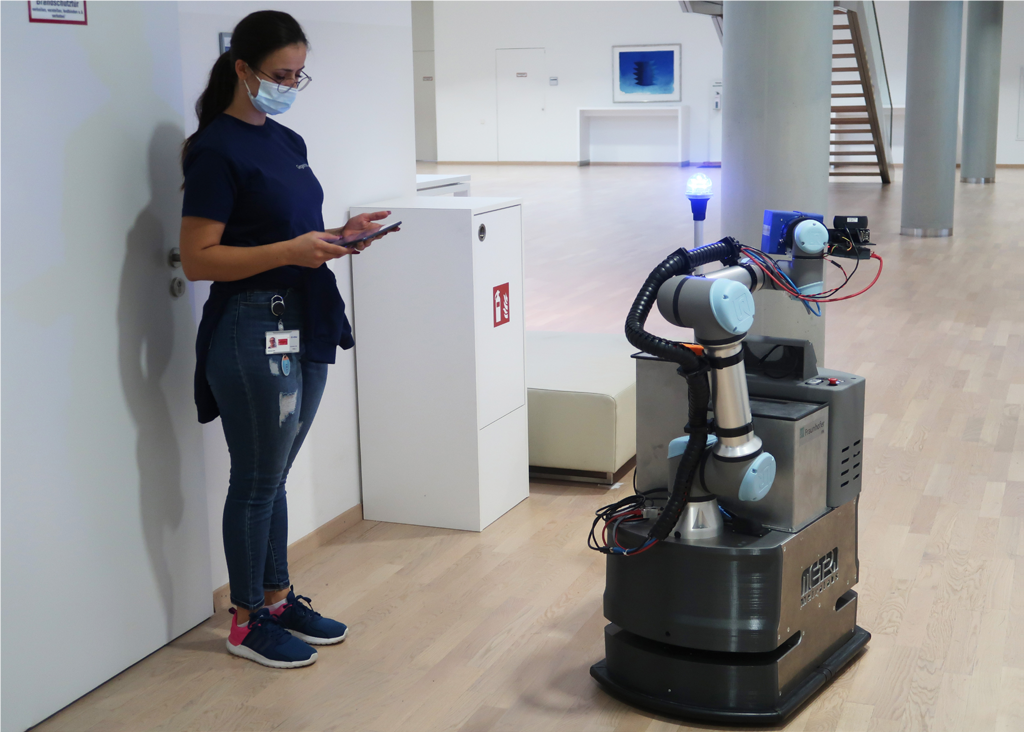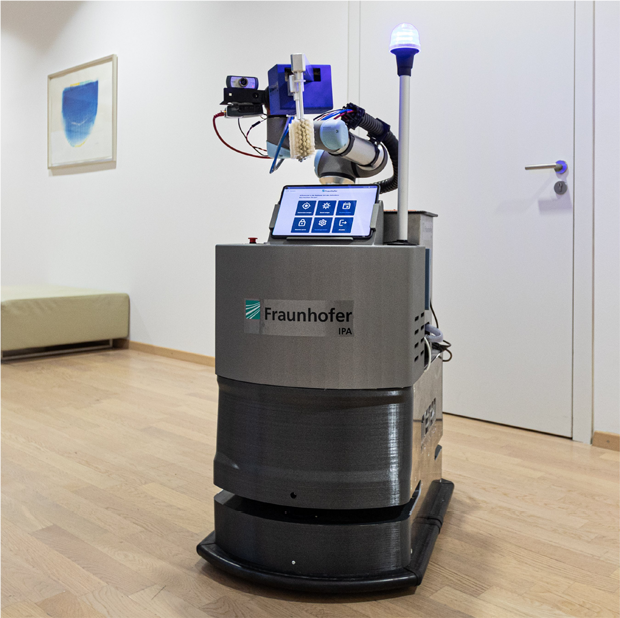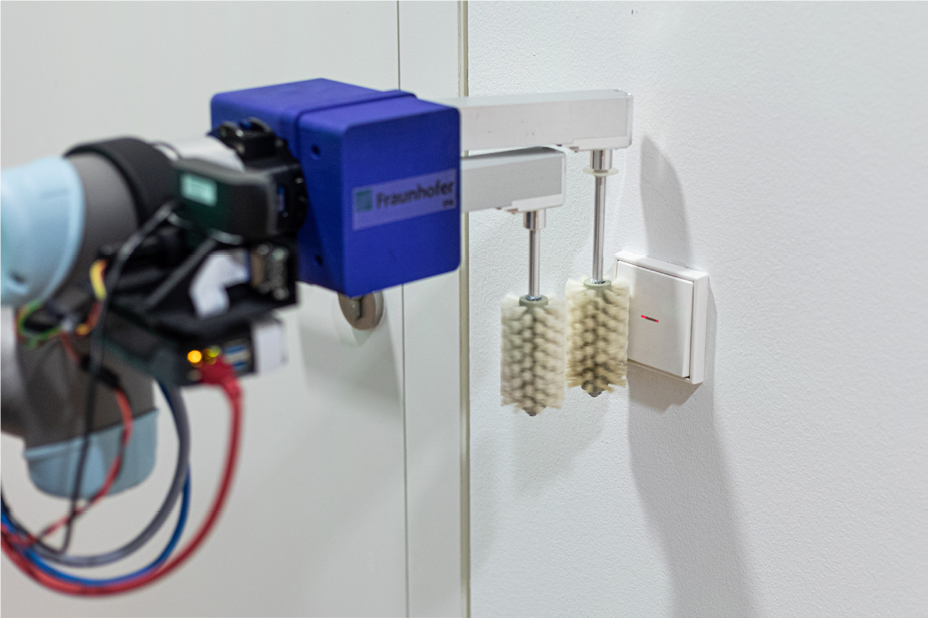Press Release
Researchers at Fraunhofer develop a new robot for wipe disinfection of surfaces
As part of the “MobDi – Mobile Disinfection” project, twelve Fraunhofer institutes were tasked with developing new key technologies for mobile cleaning and disinfection processes. The latest result of this research project is the disinfection robot “DeKonBot 2” from Fraunhofer IPA. In November 2021, the project partners presented the robot and its abilities to the public, including results from practical tests.

Cleaning and disinfection activities in buildings have constituted a primary research focus since the onset of the coronavirus pandemic. This is because they can play a role in preventing the spread of the virus. Overburdened personnel and time-consuming quality control processes have for a long time been exerting pressure on the cleaning sector. Robotic assistance systems could lend a helping hand to improve the situation. However, due to safety reasons, existing automation solutions such as UV-based disinfection robots or robots used for spray disinfection processes are only able to disinfect unoccupied rooms. This means that the strain on staff is eased only marginally. The wipe disinfection of surfaces that is often required – e.g. in hospital rooms or on technical equipment and infrastructure such as light switches and elevator buttons – continues to be carried out by cleaning staff.In order to provide targeted automation solu-tions to cope with this challenge as well as to support and to properly assist cleaning staff, in the “MobDi – Mobile Disinfection” project, which ran from October 2020 to November 2021, twelve Fraunhofer institutes have devel-oped new key technologies for robot-based cleaning and disinfection and expanded exis-ting ones. The project received funding under the “Fraunhofer vs. Corona” program.
Close-to-product prototype
In the project, the Fraunhofer Institute for Manufacturing Engineering and Automation IPA developed and built the disinfection robot “DeKonBot 2”, while the Fraunhofer Center for International Management and Knowledge Economy IMW was responsible for implementing the graphical user interface for intuitive operation. The targeted implementation areas for the robot include public buildings and healthcare facilities. In con-junction with the company MetraLabs, Fraunhofer IPA is planning to bring the robot to operational maturity over the coming year so that the product can be delivered to customers from the start of 2023. Advance orders can be placed as of now.
DeKonBot 2 is the further development of the first-generation disinfection robot with the same name originally presented by Fraunhofer IPA back in 2020. Based on the ex-perience gained, Fraunhofer IPA’s robotics experts revised and reworked the hardware components of the robot. “The further development sought to design a compact, costeffective and functional robot”, explains Simon Baumgarten, scientist at Fraunhofer IPA and responsible for the construction of the robot, adding: “An additional challenge wasto make the cleaning tool flexible and space-saving, while at the same time ensuring that it could effectively disinfect a wide variety of objects.”
The Scitos X3 developed by MetraLabs is now being used as a mobile basis. Using a simple differential drive system, it is more cost-effective than the previously used omnidirectional platform. It further offers more space for all the necessary tools. The original SCARA robot was replaced by a collaborative six-axis articulated arm robot developed by the company Universal Robots, which is able to better navigate its way around the objects to be disinfected and to reach all relevant contact surfaces. Instead of the microfiber sponge used in the previous version, DeKonBot 2 uses a brush system. The brushes are disinfected by immersing them in the tank filled with disinfectant, which in turn prevents germs from being transferred through the cleaning tool.
In terms of software, identifying the objects to be disinfected is a key technology of DeKonBot 2. The algorithms must be able to function reliably under different environ-mental conditions, for example in variable lighting conditions. Within a room the robot may need to recognize and localize door handles, doorknobs, light switches and elevator buttons of different shapes and forms. This is all facilitated by machine learning algorithms. They can identify the objects on the basis of two-dimensional RGB images and classify them into different object types to which the robot adapts its cleaning movement. A newly developed sensor system is used to determine the exact position and contour of the object to be cleaned. This is based on a line laser scanner that also detects reflective surfaces reliably and accurately.
Programming and application
Before starting its autonomous operation, in each new working environment, the cleaning staff must put DeKonBot 2 into operation. For this, they navigate the robot through the whole area that is to be cleaned, which enables the robot to automatically generate a map of the relevant environment. During this programming journey, the cleaning staff mark the position of all objects in need of cleaning by simply moving the robot in front of them. Once the initial operation of the robot has been completed, autonomous cleaning can begin.
On its autonomous cleaning journey, the robot independently covers a specific area selected by the user. Alternatively, certain routines can be defined in which the robot cleans individual areas at certain times. DeKonBot 2 moves into the pre-programmed position in front of an object to be cleaned before moving its sensor-equipped arm and cleaning tool forwards. The robot then wipes its brushes on a grid to avoid drops. Using the sensors, it measures the object to be cleaned. Based on the sensor data it then plans the necessary movement of the robot arm so that the brushes completely disinfect the handle, knob or switch. Thereafter, the robot gets down to the business of disinfecting the selected surfaces. When it has finished, the robot repositions the cleaning tool safely in its disinfectant tank and makes its way to the next object for cleaning.
Seven-day practical test and user survey
A major goal in the further development of DeKonBot was to improve product rele-vance and practical applicability. In order to check this, researchers at Fraunhofer IPA and Fraunhofer IMW carried out tests over a period of one week on one floor of an EnBW office building. Objects for cleaning included light switches, door handles and doorknobs. Three EnBW executives in addition to three managers and four cleaning specialists from the facility management firm Gegenbauer were in control of the robot. They were also tasked with programming new objects to the robot as well as launching and overseeing regular operations. Relevant performance data such as the duration of individual tasks was computed, while any errors and their frequency were also logged.
“We are really happy with the technical reliability and achieved performance data”, Baumgarten summarizes. The autonomous navigation of the robot in its operational environment worked reliably, while the recognition and disinfection of door handles and light switches was also a complete success. Only doorknobs posed occasional issues. The user tests confirmed a high level of acceptance of the robot. It was well received by the test personnel, who were able to successfully operate the robot after an introduction. All test personnel subsequently affirmed that they could easily imagine working with the robot over the longer term.
Investigating economics
The Fraunhofer IMW team also investigated the economic viability of the robot on the basis of a lifecycle cost analysis. This involved taking into account all the costs that incur in relation to the measured and future achievable performance data and the cost of the robot from purchase to disposal. The cost of a single member of cleaning staff that only disinfects the mentioned objects served as a reference value. As of now, the robot can clean 30 objects per hour under conditions such as those observed during the test. “Our calculations have shown that 45 objects per hour represents a baseline for profitable use”, explains Dr. Marija Radic, head of division at Fraunhofer IMW. In this profitable scenario, the robot is working for 24/7 (including charging processes), and the cost would be fully amortized after eight years.
This target performance is expected to be achieved with the current ongoing develop-ments and optimizations. “We will further accelerate the scanning and movement processes”, Baumgarten explains the research group’s further work. “We will also seek to improve individual components such as the cleaning tool and the tank in respect of safety and hygiene. Looking ahead, we will also program the robot to be able to open doors and ride elevators.”



